Refrigeration compressors have the function to activate a refrigerant circulation in the system they are used in. However, differently from what many may think, there are several types of refrigeration compressors in the market, each of them with specific characteristics that make them more adapt to given situations. How much do you really know about all these types of compressors and their functioning? And are you aware of their advantages and disadvantages? Take a look!
Reciprocating compressors
Reciprocating compressors are distinguished in two sub-categories:Enclose compressors with ammonia and freon and Open-crankcase compressors with the horizontal opposed cylinders arrangement. While the first mentioned work at high-speed and are irreplaceable for small production, the second ones are double-action machines with increased productivity. However, they are strongly sensitive to water hammering and for this reason are often replaced by screw compressors, which will analyze next.
Screw compressors
Screw compressors are one-or two-rotor machines of volume effect with a constant geometric degree of compression and exist in two different variants: dry or oil-filled. The advantages of screw compressors are several. Among them we find high-speed, low weight, no vibrations, no surging mode, long life time and high reliability and easy-to-use functions. In addition, as already mentioned, screw compressors are perfect to work in humid environment and do not suffer water hammering effects. Nevertheless, among the characteristics that can be found on the compressor diagram parts shown in the product details, there are a few disadvantages, such noiseness and a need of cooling at medium and high degrees of the increased pressure.
Scroll compressors
These are probably the types of compressors with the most benefits in terms of structure. In fact, they are easily able to reduce the load of the electric motor when they start off, they can ensure a uniform amount of gas release and they are extremely silent. On the contrary, they are not easy to handle due to complex manufacturing technology.
Hermetic compressors
The hermetic compressors are the first category of compressors that are integrated with the motor, together with the semi-hermetic ones. The hermetic compressors have a relatively low capacity (up to 35 kw) but they present straightforward benefits. First of all, they are compact, which makes them last long. Secondly, they are convenient in terms of price and, finally, they are rather universal, fitting almost any kind of system.
Semi-hermetic compressors
The main difference between these compressors and their fully hermetic variant is the possibility to dismantle them easily, removing the electric motor and replacing the necessary parts. Among the advantages they present, it is worth mentioning how they manage to achieve high levels of power.
Open compressors
The main feature of these machines is that the motor is external. As a consequence, the maintenance of these compressors is extremely easy if compared to their relatives and it can be a huge advantage for clients. In addition, they are also very reliable, since chances of flaws in the system are relatively rare.




